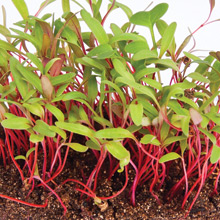
I LOVE my Tower Garden and going in it last year had opened my eyes up to alternative ways to grow and I am excited to introduce to you a guess post about Microgreens! I know nothing about this and am excited to be able to bring you info on the topic from Chris, Captain Hydroponics.
Microgreens are small greens that are harvested before they grow into full plants. Though they’re often confused with sprouts, they’re actually quite different. Sprouts are harvested right when the plant peeks through the soil. Sprouts are eaten whole, with the seed and its roots attached. Microgreens on the other hand are harvested after the sprout has already grown into a tiny plant and has sprouted its first leaf. It’s trimmed at the base; the seed and roots are not harvested.
Why Grow Microgreens?
Microgreens are very nutrient dense. An ounce of microgreens has significantly more nutritional content than an ounce of the same plant when it’s fully grown. It also has far lower space requirements. You can grow microgreens just about anywhere, even if you don’t have room for a traditional growing setup.
Microgreens can survive in almost any weather conditions. You can grow microgreens even when the full grown plant would be out of season (e.g. you can grow cabbage microgreens even when it’s not cabbage season.) They’re relatively inexpensive and easier to grow than fully grown plants
Finally, microgreens can be a fun experience for the whole family. Kids can often be intimidated by growing large plants. Things like controlling lighting, irrigation, pH values, etc. can be daunting for a child. But helping little plants grow can be a fun family project. On the flip side, because microgreens grow so quickly, they can also be a high yield produce for professional farmers.
Microgreens and Hydroponics: A Match Made in Heaven
The vast majority of microgreens grow better and faster in a hydroponic environment. For example, arugula, cabbage, celery, basil, cilantro, mustard and radish all grow better with hydroponics. Only a small handful of microgreens (sunflower seed plants, beet and cilantro are the main three) do better in soil.
One of the big reasons hydroponics is superior for growing microgreens is because of the way microgreens are harvested. Typically, microgreens are not washed after harvest. If they’re planted in soil, that means you’ll have a gritty, grainy texture from leftover sediment. With hydroponics, that’s not an issue.
The easiest way to get started with microgreens and hydroponics is with a microgreens kit. These kits will set you up with everything you need to know to get started, as well as give you basic instructions. You can also buy the seeds on your own and set it up yourself.
When you’re buying your seeds, make sure you’re buying seeds that are specifically designed for microgreens. Non-microgreen seeds are coated with fungicide. This is great for planting regular plants, but detrimental to both the hydroponic environment and the microgreen itself.
Getting started with microgreens is easy. You don’t need to do a ton of research before starting. Why not give it a try for yourself?
About the Author: Chris Wimmer is an urban hydroponic hobbyist who uses hydroponics to maximize his 400 square foot yard and extend the short Chicago growing season. Chris blogs about his hydroponic experiences at Captain Hydroponics and is on facebook.






{ 2 comments… read them below or add one }
nice
Hydroponics although difficult for newbie but if master it will have higher productivity